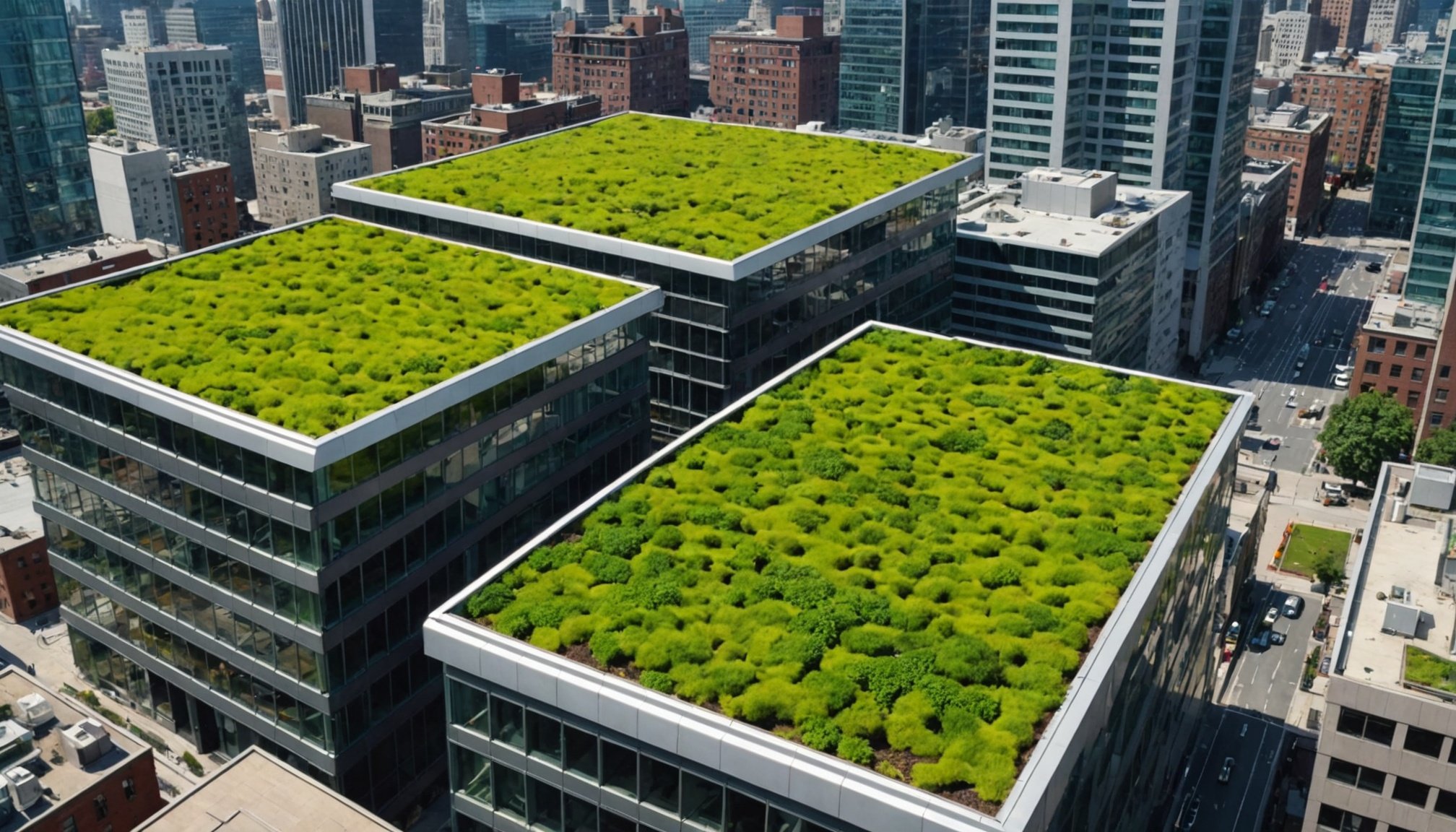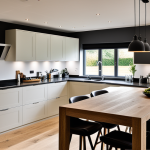Harnessing the Power of Green Roofs: Cost-Efficiency and Environmental Impact in Urban Landscapes
In the heart of bustling cities, where concrete and steel dominate the skyline, a quiet revolution is underway. Green roofs, also known as vegetated roofs or eco-roofs, are transforming urban landscapes, offering a plethora of benefits that extend far beyond their aesthetic appeal. This article delves into the world of green roofs, exploring their cost-efficiency, environmental impact, and the myriad ways they are reshaping our cities.
The Concept of Green Roofs
Green roofs, which originated in Europe in the 1970s, integrate a complete vegetal ecosystem into the urban environment. These roofs are designed to promote sustainability, biodiversity, and environmental protection, while also providing a unique aesthetic solution for urban spaces[1][3].
“Green roofs are more than just a trendy architectural feature; they are a vital component in the fight against climate change and urban pollution,” notes a leading environmental architect.
Benefits for the Building
Green roofs offer several direct benefits to the buildings they adorn.
Prolonging Infrastructure Life
Green roofs act as a natural shield against UV rays and thermal variations, protecting the waterproofing materials and thus extending their lifespan. This natural protection can increase the durability of the roofing materials by up to 40 years, as highlighted by architectural studies[2][3].
Enhancing Thermal and Acoustic Comfort
The vegetal cover optimizes thermal insulation and reduces noise pollution, ensuring a comfortable indoor environment throughout the year. This dual benefit is particularly significant in urban areas where noise and temperature fluctuations are common issues[1][3].
Aesthetic Value
Green roofs create living landscapes that are visually appealing and ecologically rich. With a wide range of vegetation options, these roofs can be personalized to fit the architectural style of any building, adding a unique and dynamic element to urban design[1][3].
Benefits for the Climate
Green roofs play a crucial role in mitigating urban climate challenges.
Reducing Energy Consumption
By acting as natural insulators, green roofs reduce the need for air conditioning in summer and heating in winter, leading to significant energy savings. Research by Environment Canada has shown that a 10 cm thick layer of soil can reduce cooling needs by up to 25%[1].
Mitigating Urban Heat Island Effect
Green roofs serve as thermal regulators, cooling the urban environment and reducing the urban heat island effect. This is particularly important in densely populated areas where heat islands can exacerbate climate-related issues[1][2][3].
Benefits for the Environment
Green roofs have a profound impact on the environmental health of urban areas.
Improving Air Quality
Vegetation on green roofs captures and filters atmospheric pollutants, including fine particles and harmful gases, thereby improving air quality. This is a critical benefit in urban areas where air pollution is a significant health concern[1][3].
Reducing CO2 Emissions
Through photosynthesis, the plants on green roofs absorb CO2, contributing to the reduction of greenhouse gases in the atmosphere. This active role in combating climate change makes green roofs a valuable green infrastructure component[1][3].
Optimized Stormwater Management
Green roofs absorb a significant portion of rainfall, reducing runoff and the risk of urban flooding. This natural filtration system also helps in removing heavy metals and nitrogen from the water, improving overall water quality[1][2][3].
Cost Considerations and Challenges
While green roofs offer numerous benefits, they also come with some cost and maintenance challenges.
High Installation Costs
The initial investment for a green roof is significantly higher than for a traditional roof, often 4 to 5 times more expensive. This cost includes specialized materials, substrate, and systems necessary for ensuring waterproofing and durability[1][2].
Additional Weight and Structural Requirements
The added weight of the substrate and vegetation requires a prior assessment of the building’s load-bearing capacity. Extensive green roofs, which are lighter, require less structural modification but still need to be evaluated for their load capacity[1][2].
Ongoing Maintenance
The maintenance needs vary depending on the type of vegetation chosen (extensive, semi-intensive, or intensive). Intensive green roofs, for example, often require irrigation systems to ensure the health of the plants, necessitating regular monitoring[1][2].
Types of Green Roofs
Green roofs can be categorized into three main types, each with its own set of characteristics and requirements.
Extensive Green Roofs
These are the lightest and least expensive option, requiring minimal maintenance. They typically use drought-resistant plants and a thin layer of substrate (usually less than 10 cm). Extensive green roofs are ideal for buildings with limited structural capacity[1].
Semi-Intensive Green Roofs
These roofs use a thicker substrate (between 12 and 30 cm) and support a more diverse range of plants, including perennials, bulbs, and grasses. They require moderate maintenance, including irrigation to maintain plant health[1].
Intensive Green Roofs
These are the most complex and expensive option, designed to support a wide variety of plants, including trees and shrubs. Intensive green roofs require regular maintenance, including irrigation and fertilization, and are often used to create rooftop gardens and recreational spaces[1].
Practical Insights and Actionable Advice
For those considering the installation of a green roof, here are some practical insights and tips:
- Assess Structural Capacity: Before installing a green roof, ensure that the building can support the additional weight of the substrate and vegetation.
- Choose the Right Vegetation: Select plants that are suitable for the local climate and the type of green roof you are installing.
- Invest in Proper Waterproofing: A robust waterproofing system is essential to protect the building from potential leaks and damage.
- Plan for Maintenance: Regular maintenance is crucial for the health and longevity of the green roof. This includes irrigation, pruning, and monitoring for any issues.
Table: Comparative Benefits of Green Roofs
| Benefit | Extensive Green Roofs | Semi-Intensive Green Roofs | Intensive Green Roofs |
|---|---|---|---|
| Cost | Lower | Moderate | Higher |
| Maintenance | Minimal | Moderate | High |
| Weight | Lighter | Moderate | Heavier |
| Plant Diversity | Limited | Moderate | High |
| Energy Savings | Moderate | High | Very High |
| Stormwater Management | Good | Better | Excellent |
| Air Quality Improvement | Good | Better | Excellent |
| Aesthetic Value | Good | Better | Excellent |
Green roofs are more than just a trendy architectural feature; they are a powerful tool in the fight against climate change, urban pollution, and environmental degradation. By offering significant energy savings, improving air quality, managing stormwater, and enhancing the aesthetic appeal of buildings, green roofs are a multifaceted solution for modern urban challenges.
As cities continue to grow and urbanization intensifies, the importance of green infrastructure like green roofs will only increase. Whether you are a homeowner, a business owner, or an urban planner, considering the installation of a green roof is a step towards creating more sustainable, resilient, and environmentally friendly urban areas.
In the words of a leading urban planner, “Green roofs are not just a luxury; they are a necessity for the cities of tomorrow. They represent a commitment to environmental sustainability and the well-being of future generations.”







